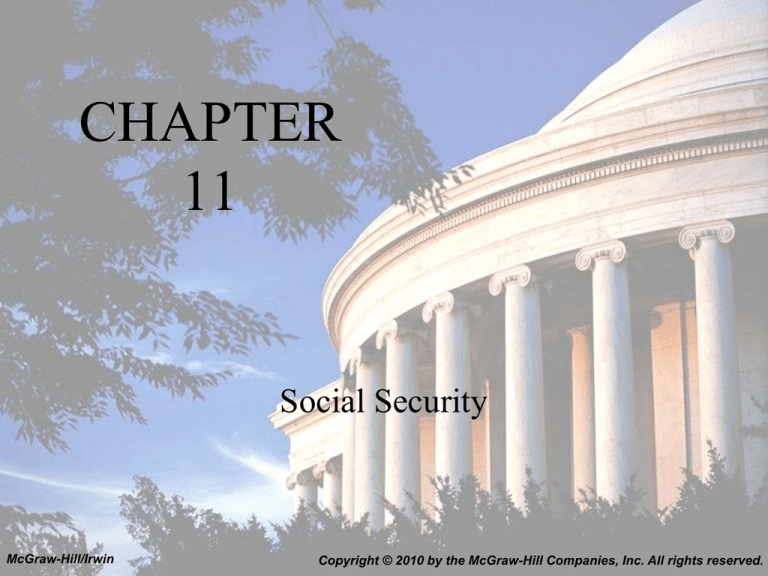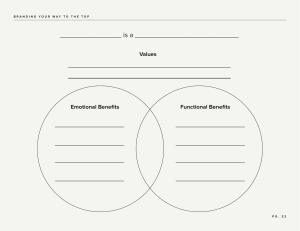
CHAPTER
11
Social Security
McGraw-Hill/Irwin
Copyright © 2010 by the McGraw-Hill Companies, Inc. All rights reserved.
Social Security Expenditures
(1939-2007)
Source: Social Security Trustees [2008].
11-2
Why Have Social Security?
• Consumption Smoothing and the Annuity
Market
– How Social Security works
– Annuity
– Consumption smoothing
• Adverse Selection and the Annuity Market
– Asymmetric information
– Adverse selection
11-3
Other Justifications
• Lack of foresight and paternalism
• Moral hazard
• Economize on decision-making and
administrative costs
• Income Redistribution
• Improve the Economic Status of the Aged
11-4
Fully Funded Plan
Period 1 Period 2 Period 3 Period 4
The Greatest
Generation
Work
contribute
The Baby Boom Childhood
Generation
Generation X
Unborn
Retire
Dead
Each generation’s
benefits
benefits based on
deposits it made during
Retire
Work
working life plus
accumulated interest
contribute
benefits
Childhood
Work
contribute
Still
Dead
Dead
Retire
benefits
11-5
Pay As You Go (or Unfunded)
System
Period 1 Period 2 Period 3 Period 4
benefits
The Greatest
Generation
Work
Retire
contribute
benefits
The Baby Boom Childhood
Generation
Generation X
Unborn
Work
Each generation’s
Dead
Still
benefits come from
tax
Dead
payments made by
current workers
Retire
Dead
contribute
benefits
Childhood
Work
Retire
contribute
benefits
11-6
Today’s Partially Funded System
Period 1 Period 2 Period 3 Period 4
benefits
The Greatest
Generation
Work
contribute
The Baby Boom Childhood
Generation
Generation X
Unborn
Baby Boomers
and Gen X are
Retirealso
Dead
contributing to
their own
benefits
retirement
Work
Retire
Still
Dead
Dead
contribute
benefits
Childhood
Work
Retire
contribute
benefits
11-7
Explicit Transfers
• Benefits for dependents and survivors (1939)
• Supplemental Security Income
11-8
Benefits
• How to calculate benefits
– AIME (Average Indexed Monthly Earnings) –
average monthly earnings in 35 highest paid years
• Wages indexed for inflation
• Ceiling on AIME – up to tax ceiling
11-9
Benefit Structure
If AIME < $711 PIA = .90*AIME
If $711< AIME <$4288 PIA = .90*$711 + .32*(AIME - $711)
If AIME > $4288 PIA = .90*$711 + .32*($4288-$711) + .15*(AIME - $4288)
$2,500
First
Break
Point
$2,000
$1,500
Second
Break
Point
$1,000
$500
$0
$0
$1000 $1500 $2000 $2500 $3000 $3500 $4000 $5000 $5500
11-10
Adjustments
• Annual inflation adjustment
• Age at which benefit is drawn
– Normal retirement age
– Early retirement – benefit reduced 5/9th of one
percent a month for first 36 months preceding
normal retirement age
– Late retirement – benefit increased 8% a year
11-11
Adjustments
• Family Status
– +50% for spouse or dependent child
– If covered worker dies spouse receives 100% of worker’s benefit
or spouse’s own benefit (whichever is higher)
– Divorced spouse married at least 10 years gets spouse benefit if
not remarried while covered worker alive
• Earnings test and taxing benefits
– Benefits reduced $1 for every $2 earned above $14,160
– Individuals losing benefits may have later benefits increased
– Up to 85% of benefits taxed for recipients with income above a
base amount ($25,000 for single and $32,000 for married
taxpayers.)
11-12
Financing
• FICA (Federal Insurance Contribution Act)
• 2008 Social Security Tax rates
– Employee
– 6.2% (OASI - 5.6%, DI - .6%) of first $102,000 of earnings on
both employee and employer
– Self-employed
• 12.4%
• 2008 Medicare Tax rates
– 1.45% on both employer and employee with no earnings ceiling
• Why not fund Social Security through general tax revenues?
11-13
Distributional Issues
• Actuarially fair return
• Intergenerational redistribution
– Total benefits = Nb * B
– Total taxes = t * Nw * w
– If total benefits = total taxes:
Nb * B = t * Nw * w or
B = t * (Nw/Nb) * w
• Ida Mae Fuller
11-14
Ida Mae Fuller
11-15
Single Male
400
All values expressed in 2006
dollars.
High
Max
-600
-800
-1000
Year Cohort Turns 65
One-earner Couple
Tw o-earner Couple
400
400
200
200
0
Low
-200
Average
High
-400
Max
-600
0
Average
-200
High
Max
-400
-800
-600
-1000
-800
Year Cohort Turns 65
Low
19
40
19
60
19
80
20
00
20
20
20
40
20
60
See C. Eugene Stueuerle and
Jon M. Bakija [1994] for
original tables and
methodology.
Average
-400
Thousands of 2006 Dollars
Source: Updated tables,
furnished by C. Eugene
Steuerle and Adam Carasso,
2006.
Low
-200
19
40
19
60
19
80
20
00
20
20
20
40
20
60
Representative
Individuals
0
Thousands of 2006 Dollars
Social
Security
Wealth:
Thousands of 2006 Dollars
200
Year Cohort Turns 65
11-16
Other Distributional Issues
• Redistribution within a generation
–
–
–
–
Differences by earnings
Differences by lifespan
Differences by living arrangements
Differences by number of earners in the family
• Normative evaluation
11-17
The Social Security Trust Fund
Worker
Trust
Fund
Retiree
• Social Security and National Saving
• Budget Treatment of Social Security
– Off budget
– Unified budget
11-18
Social Security and Savings
Behavior
•
•
•
•
Life-cycle theory of savings
Wealth Substitution Effect
Retirement Effect
Bequest Effect
11-19
Future consumption (c1)
Budget Constraint for Present and Future Consumption
N
D
(1+r)S
I1 + (1+r) S
At endowment
point consumer
neither saves nor
B borrows
I1
(1+r)B
F
S
I1 - (1+r) B
M
I0 - S
I0
Present consumption (c0)
11-20
Future consumption (c1)
Utility-maximizing Choice of Present and Future
Consumption
N
c1*
E1
A
I1
Saving
c0*
I0
M
Present consumption (c0)
11-21
Future consumption (c1)
Crowding out of private saving due to Social
Security
N
E1
c1*
R
A
I1
(1+r)T
TSaving after
Saving before
Social Security
Social Security
M
c0*
I0T
I0
Present consumption (c0)
11-22
Empirical Evidence: Does Social Security
Reduce Saving?
• Time-series evidence
– Martin Feldstein (1974, 1996) v Leimer and
Lesnoy (1982)
• Cross-section evidence
• Evidence from other countries
– Attanasio and Brugiavini (2003) and Italy
11-23
Other ways Social Security Affects Saving
• Retirement effect
• Bequest effect
• Empirical evidence
11-24
Distribution of Wealth
• Bequeathable vs. Annuitized Wealth
• Effect of Social Security on Bequeathable
Wealth
• Effect on Wealth Mobility
11-25
Retirement Decisions
• Social Security wealth and the retirement
decision
• Empirical evidence
– Diamond and Gruber [199]
– Gruber and Wise [2004]
11-26
Long-Term Stresses on Social
Security
Projected revenues and projected costs of Social Security as share of Gross Domestic Product
Source: Social
Security Trustees
[2006]
11-27
Long-Term Stresses on Social
Security
Since: B = t * (Nw/Nb) * w
Rearrange: t = (Nw/Nb) * (B/w)
Dependency Ratio
Replacement Ratio
11-28
Social Security Reform
• Time horizon for solvency
– Sustainable solvency
11-29
Maintain the Current System
•
•
•
•
•
•
Raise the payroll tax
Raise the Maximum Taxable Earnings Level
Raise the Retirement Age
Reducing the Cost-of-Living Adjustment
Change the Benefit Formula
Comparing the Options
11-30
Privatize the System
• Personal Accounts
• Pros and cons of personal accounts
– Effect on Solvency
– Effect on Saving
• Carve-out accounts
• Add-on accounts
– Risk
– Administration
– Distribution
11-31




